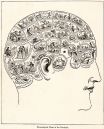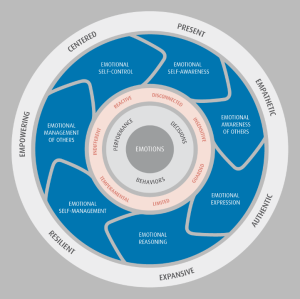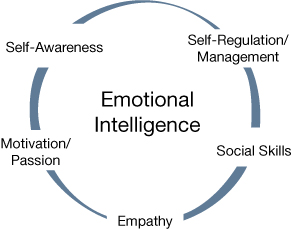Strategies for Managing the Irrational Manager
The principal director of Eureka Training, Nick Mills—also a Neuroscience of Leadership graduate and a leading expert in emotional intelligence in Australia—looks at irrational responses in the workplace and offers effective neuroscience-based strategies for dealing with them.
_____________________________________________
‘I judge you on your behaviour, however, I judge me on my intent’.
When we look to others behaviour in the workplace, we tend to only look at the outward results of their actions in making judgements on the intent of those actions. A careless remark by a manager, a ‘thoughtless’ lack of thanks for a great job done, an unreasonable request or, worse, an over the top reaction to a mistake can, and rightly does, upset our sense of social justice in the workplace and our sense of what may be right and wrong in terms of how to behave.
Sometimes we may react irrationally back at the person, however we won’t be as critical of our own reaction because we have the benefit of knowing our INTENT as well. At other times we retreat, we may sulk, we may engage in avoidance behaviour or we may just stonewall. A lot of the time, our reactions actually make it worse for us, while the irrational person seemingly wanders off and feels vindicated now that they’ve ‘put us in our place’. Major frustration.
Getting better at dealing with ‘bad’ behaviour
We can maximise our impact on those we perceive we have trouble influencing, as well as those we feel are irrational, by first examining our own reaction to the aforementioned behaviour. The idea behind this is that if you build your own self-regulation strategies and self-management tools, you can enhance your own effectiveness and also reduce the incidents of irrational behaviour in others by influencing and managing their behaviour.
The SCARF model, by David Rock, a leading neuroscience practitioner, builds on the understanding that the brain is focused on increasing or sustaining reward and avoiding negative experiences. From this focus on reward and avoidance of negativity develops various drives and behaviours in the workplace. Let’s look at each of these five areas of social response in a little detail:
1. Status
Our sense of worth. Our sense of where we fit into the hierarchy at work both socially and organisationally. When we are given praise or criticism this will influence our status. Feelings of threat are processed uniquely by each of us. For example, being given a small ‘tip’, can already be seen as a threat and stimulate a defensive reaction. Positivity and positive feedback is a much more effective way to generate wider status effects. This stimulates the brain’s reward centres and creates a positive environment for the brain.When we feel our own sense of status being threatened, we are less likely to respond in a way that helps the situation, we are more likely to ‘cherry pick’ pieces of information being sent by the other person and therefore.
Strategy for Improvement: We are more cued for ‘threat’ than ‘reward’ situations in the workplace. Take time to notice whether you are feeling slightly more threatened by someone’s behaviour and how that’s impact your sense of self. Status is a significant driver of workplace behaviour. You may just be encountering someone else’s extreme status threat response that’s unfortunately taking it out on you.
2. Certainty
Asking for clarity around tasks, asking for clarity around people and how people communicate is more important than you probably realise. In familiar situations the brain uses fewer resources than in unfamiliar situations. This means that in unfamiliar situations the brain will be strained, it will be uncomfortable. In familiar situations where the outcomes are predictable the reward system will be activated and a feeling of security will be generated. When we are asked to complete tasks or be involved in situations where we don’t have certainty about process or what the persons expects from us, it increases our stress levels dramatically and impairs our ability to be able to make effective balanced decisions.
Strategy for Improvement: Ask direct questions about expectations. Don’t try and ‘fill in the gaps’ with your imagination. If you are engaging in a task that someone has asked you to do and you don’t feel you have clarity, keep asking questions until you do. When we find ourselves ‘reading meaning’ into situations, it may be time to directly ask what was meant, as often its meaning is not what we thought it was. We spend 40% of our time predicting the future and most of the time we are wrong.
3. Autonomy
‘I have no control over my world.’ ‘I wish they would let me get my job done the way I want to do it, it would be so much better.’
Our ability to get things done through others is critical in the workplace. Our need to feel safe in our abilities to get our job done competently without overt interference enhances our productivity, our engagement, our effectiveness and our accuracy. Lack of autonomy can be processed as a threat situation and hence will promote stress and its negative implications in the brain. Interestingly just being promised more autonomy will activate the reward system in the brain.
Strategy for Improvement: Focus on what you can control in your world. Taking the time to focus on what you do have control of in your world (either at work or outside of work) helps to build perspective and increase the sense of autonomy.
4. Relatedness
‘I just can’t relate to this person’. ‘She/he makes no effort to understand my perspective, it’s all about them.’
The social wiring in our brains means that in daily life and in business alike, we form social groups and build relationships. These groups build mutual trust and form a barrier against the unknown. These feelings and the interpersonal bonding promote the production of oxytocin, the trust and bonding hormone, which increases the positive feeling of trust and stabilizes these relationships.
But what do we do when we don’t feel a sense of connection?
Strategy for Improvement: Engage in some ‘cognitive empathy’. Too often when we try to engage in empathy we are actually engaging in misplaced sympathy (or what we’d do if WE were them). Cognitive empathy is about our ability to really try to be in that person’s shoes and engage with that person’s perspective. A difficult and tricky thing when they might be yelling or narky at us. By engaging in cognitive empathy which is about MAKING yourself look at it from their perspective, it can engage the flow of oxytocin.
5. Fairness
‘I can’t believe he just gave me that job to do; I can’t believe she spoke to me that way.’
Unfairness stimulates a strong emotional reaction in the brain, an automatic defence mechanism. This emotional reaction can for example be to shut down, with punishment of the source of the unfairness. This activates the reward centre in the brain and counteracts the negative impact of unfairness. This feeling of unfairness can unintentionally be promoted in organisations through unclear and in-transparent communication. When we experience a strong unfairness threat (and irrational behaviour in others can cause that), we can quite often respond in a way that either exacerbates the situation or attempts to avoid the threat. Either are short-term fixes.
Strategy for Improvement: Label and reappraise: How am I actually feeling in this incident? What impact is it having on my ability to be rational in response? How long is it likely to last and what’s another, more constructive way for me to react to it?
It’s all about gaining perspective
The essence of this model helps us to feel more energised, more trusting of colleagues, more engaged in our workplace and overall have a better understanding of why people do what they do. The essence of this model is around gaining perspective. Negativity, irrational behaviour and conflict or however we wish to label it isn’t just something that makes our jobs uncomfortable from time to time, it is a real cost to business in the emotional toll it takes among staff morale. More compellingly, it translates to lost time due to a lack of engagement leading to lower productivity, increased time spent by human resources or the practice manager having to deal with issues, and of course, the ever increasing litigious nature of our culture.
Finally, focus on your own and others SCARF triggers. That person’s irrational reaction may be due to an unwitting status threat they experienced from another source that is currently being transferred to us. We have the power and the choice to respond and react however we choose. Make it proactive. Make it constructive. And make it kind to your brain.
.
This article was first published in August 2013 in Survival Guide for Legal Practice Managers, the Australasian Legal Practice Management Association blog.
_____________________________________________
 Nick Mills is an experienced leadership facilitator and coach with a passion for learning and facilitating change, and Principal Consultant at Eureka Training. He has worked with senior managers in professional services, corporate, not-for-profit and government agencies in Australia, as a leadership program facilitator, coach, trainer’s trainer and sales trainer. Nick has successfully managed and led management and leadership programs focused on building individual capability, with an emphasis on neuroscience, developing emotional intelligence and personal resilience.
Nick Mills is an experienced leadership facilitator and coach with a passion for learning and facilitating change, and Principal Consultant at Eureka Training. He has worked with senior managers in professional services, corporate, not-for-profit and government agencies in Australia, as a leadership program facilitator, coach, trainer’s trainer and sales trainer. Nick has successfully managed and led management and leadership programs focused on building individual capability, with an emphasis on neuroscience, developing emotional intelligence and personal resilience.
Nick is accredited in a range of contemporary leadership tools, including Genos EI, Neuroscience, DISC, Situational Leadership and NLP. He is also a devotee of lifelong learning. Nick holds a Bachelor of Adult Education and Masters of Education and has recently completed a Diploma of Neuroscience of Leadership.
Mind Matters: Neuroleadership in Action
In the second of a two-part series, journalist Becky Barker speaks with NeuroCapability leaders Vivienne Greene, a human resources specialist, and Nick Mills, principal consultant and owner of Eureka Training, about putting the principles of neuroleadership into action.
_____________________________________________
After more than 20 years in human resources, Vivienne Green wanted to upskill in a way that would address the demands of the business world both today and tomorrow. “I was looking for a program that would take me into the future and really lift my knowledge and while a lot of people decide to do an MBA, that’s not what I was looking for,” says Green, who is Vice President of Human Resources at global pharmaceutical company Biota.
Having already completed a psychology degree, Green was drawn to the Diploma of the Neuroscience of Leadership program run by the training organisation NeuroCapability. The course, which is conducted fully online or in a mixed mode format with 4 two day face-to-face workshop, teaches how information we now know about brain function can assist in changing our behaviours in a corporate environment.
Teaching includes David Rock’s SCARF principles. It shows how the five domains of social experience (Status, Certainty, Autonomy, Relatedness and Fairness) need to be addressed in our dealings with other people to keep them calm, creative, engaged and positive.
Green says:
One of the things I found most interesting was how to manage change for organisations – how employees collaborate with one another and the impact of leaders on others. For example, the whole idea around threats and rewards, the fact that we respond strongly and quickly to threats and well to rewards and that emotional hurts, social exclusion or bullying activate the same area of the brain as a threat to one’s life.
Since completing the program earlier this year, she has been applying her new-found knowledge to recruitment, onboarding and organisational change. “When you have been interviewing people for years you forget how nervous they are. From the point of view of certainty, I explain the structure of the interview, how many interviews there will be and when they will know the outcome. I build a rapport to address relatedness, treat every candidate the same for fairness and ensure I am there on time to enhance their feeling of status,” says Green, who admits the scientific approach appeals to Biota’s academic staff.
 Nick Mills, principal consultant and owner at Eureka Training has also completed the diploma and says it has enhanced his teachings on emotional intelligence, which he backs up with a 360-degree learning tool on EI called GENOS. “If I’m training someone who is very cynical about emotions in the workplace, I can now explain and demonstrate using the teachings of science that this is actually happening in the brain,” says Mills.
Nick Mills, principal consultant and owner at Eureka Training has also completed the diploma and says it has enhanced his teachings on emotional intelligence, which he backs up with a 360-degree learning tool on EI called GENOS. “If I’m training someone who is very cynical about emotions in the workplace, I can now explain and demonstrate using the teachings of science that this is actually happening in the brain,” says Mills.
Despite criticism of neuroleadership as a fad, its supporters say it is inspiring and practical. Linda Ray, managing director of NeuroCapability says we need to change our ways to manage the explosion of stress in the workplace and help organisations manage change.
“There is strong evidence that the ‘command and control’ management techniques do not get the best out of people or keep them fully engaged but despite this we are still using processes that are not brain friendly,” says Ray.
.
This article first appeared in HRmonthly in June 2013.
_____________________________________________
 Becky Barker is a former magazine editor (Time Inc) who started out as a journalist on British newspapers (Oxford Mail and Times/Hounslow Chronicle) before working at Fairfax Media (Sun Herald) as a sub editor and writer. She is a regular contributor to HR Monthlymagazine, lifestyle magazines and specialist features in Fairfax publications with a particular interest in the field of human resources and women in business.
Becky Barker is a former magazine editor (Time Inc) who started out as a journalist on British newspapers (Oxford Mail and Times/Hounslow Chronicle) before working at Fairfax Media (Sun Herald) as a sub editor and writer. She is a regular contributor to HR Monthlymagazine, lifestyle magazines and specialist features in Fairfax publications with a particular interest in the field of human resources and women in business.
Building emotional neurocapability: Leadership expert Nick Mills
NeuroCapability Breakfast Forums
NeuroCapability is committed to bringing the most engaging practitioners in the neuroscience of leadership to speak at our regular Breakfast Forums. On 21 March 2013, Nick Mills from Eureka Training presented a stimulating talk on the importance of developing greater emotional “neurocapability” in the workplace and revealed how self-awareness and self-regulation can be enhanced to lead positive change.
_____________________________________________
.
Accredited in a range of contemporary leadership tools, including the Diploma of the Neuroscience of Leadership, Nick Mills is a devotee of lifelong learning. His approach to leadership learning is based on the fundamental idea that change begins with the individual and that being “your best you” is more than achievable.
During the talk, Mills emphasised that emotional intelligence is nothing more complicated than using emotions intelligently for business, professional, and personal mastery. “As we’ve begun to understand more about our brains and what neuroscience can teach us about maximising our effectiveness, the interplay between these two popular behavioural tools is never more relevant than now,” Mills explained.
“It’s simple,” he added, “but that doesn’t mean it’s easy.”
Basing his talk on the elements of the Genos model of emotional intelligence, Mills explained how we can utilise the very latest in neuroscience research to maximise existing emotional intelligence tools. Having a basic knowledge of the brain and its functionality can serve as the foundation for an enhanced understanding of the effectiveness of emotional intelligence in the workplace and, in turn, for building a more emotionally aware and resilient workforce.
 “We express our emotions through our behaviour in encounters with others,” Mills said. “Being in tune with our moods and feelings means that we’ll demonstrate greater awareness of how our behaviour influences others.” Mills likens this behaviour to the wake of a boat moving through a harbour—depending on a number of factors, encountering others can either be smooth or choppy, either a positive or a negative experience. Self-awareness yields better self-regulation, which creates opportunities for more positive interactions.
“We express our emotions through our behaviour in encounters with others,” Mills said. “Being in tune with our moods and feelings means that we’ll demonstrate greater awareness of how our behaviour influences others.” Mills likens this behaviour to the wake of a boat moving through a harbour—depending on a number of factors, encountering others can either be smooth or choppy, either a positive or a negative experience. Self-awareness yields better self-regulation, which creates opportunities for more positive interactions.
We know emotions are contagious. Your mood as a leader matters. How susceptible are you to catching the emotions of others? In an article by Sherrie Bourg Carter, “5 Ways to Avoid Catching a Bad Case of Emotions“, the author makes suggestions in relation to how to either learn to work around emotions or change them. In a related article, Carter suggests undertaking The Emotional Contagion Scale, which contains a 15-item questionnaire to help you gauge how vulnerable you are to emotional contagion.
As Mills suggests, self-awareness is key. Knowing your own susceptibility to catching emotions can assist you in “being your best you”. Ask yourself: “What mood am I taking into a room?” and “What mood do I want to leave behind (emotional wake)?” These two simple questions are key components of tapping into your emotional intelligence.
_____________________________________________
About our presenter
 Nick Mills
Nick Mills
Nick Mills is an experienced leadership facilitator and coach with a passion for learning and facilitating change. He has worked with senior managers in retail, corporate, not-for-profit and government agencies in Australia, as a leadership program facilitator, coach, trainer’s trainer and sales trainer. He currently facilitates many neuroscience and Emotional Intelligence related topics as well as accredited training. He has successfully managed and led management and leadership programs focused on building individual capability, with an emphasis on neuroscience, developing emotional intelligence and personal resilience. Business leaders have described his coaching as insightful and transformative.
Read Full Post | Make a Comment ( None so far )Linking Emotional Intelligence to Neuroscience
Nick Mills, a Neuroscience of Leadership graduate and the Principal Consultant at Eureka Training, shares his thoughts on emotional intelligence and what learning about the brain can do to help you link the heart with the head.
___________________________________________
“I don’t go in for any of that fluffy stuff at work. Feelings should be kept at home and kept out of work,” declared Steven, the head of Information Technology in Projects at a large well-known software organisation.
This was the first thing to come out of Steven’s mouth as Neil sat down to conduct a pre-arranged 360 degree Emotional Intelligence coaching session with him, arranged by Steven’s Manager. Steven had made both his intentions clear and his feelings known about Emotional Intelligence.
 The irony was not lost on Neil, at least he had something to work with. Steven, a self-professed ‘facts, figures and stats’ kind of guy, was only interested in concrete concepts and ideas proven that have a dependency of outcome. Unfortunately for Steven, and anyone else involved with human beings, the outcome you’d like isn’t always what you get when you deal with people on a day-to-day basis.
The irony was not lost on Neil, at least he had something to work with. Steven, a self-professed ‘facts, figures and stats’ kind of guy, was only interested in concrete concepts and ideas proven that have a dependency of outcome. Unfortunately for Steven, and anyone else involved with human beings, the outcome you’d like isn’t always what you get when you deal with people on a day-to-day basis.
In its purest form, Emotional Intelligence as a concept has been around for thousands of years. Plato articulated concepts such as these in his writings. More recently, Howard Gardner mentioned it in 1983 when he first conceptualised ‘multiple intelligences’. The concept was further popularised in the early 1990s by John Mayer and Peter Salovey , who later went on to form the MSCEIT Emotional intelligence test. Daniel Goleman’s 1995 seminal book Emotional Intelligence: Why it matters more than IQ really put EI on the map and into our consciousness, so to speak.
Steven was about to sit down to have his one on one debrief of the Genos Emotional Intelligence 360 degree report. Understandably, his nerves were on high alert as his brain grappled with the concept of the large threat looming in the debrief of this report. Steven had been receiving several complaints per month from his staff and peers. Complaints ranged from bullying to aggression, to overly unrealistic demands and rudeness, among others things. Little wonder that Steven was feeling more than threatened by the concept of this coaching session.
Neil understood that Steven’s stance masked a deeper inner concern: What would his staff , his peers, and his manager say about him, and what would the impact be? Were they engaged or were they disengaged? Suddenly, it mattered.
There is a wealth of literature linking high employee engagement and positive emotions among employees defining high performance workplaces. Steven was about to find out a little more about his team.
This is a common conundrum facing any coach, HR Manager, Manager, Team Leader, or Supervisor who has ever had to sit down and ‘coach’ someone through the impact of a 360 degree (mostly anonymous) feedback survey. Naturally, the brain heads toward an automatic threat response in this kind of situation. Having some understanding of neuroscience, as well as emotional intelligence, helped Neil.
 Neil chose the Genos model of EI, a popular Australian based EI tool because it comes with a raft of research and a wealth of helpful tools. The Genos model focuses on seven key ‘skill areas’ of emotional intelligence, as it looks upon emotional intelligence as a ‘learnable’ skill, rather than a fixed narrative. This is useful in several ways, particularly for those that eschew populist ‘consultant speak’ or ‘psycho-babble’. It’s based on science and some pretty solid research. Being able to back it further with some simple, irrefutable brain-based facts can be even more helpful for the coach or the manager. For example, our brains core motivation underlying all behaviour and brain processing is to minimize threat and maximize reward. This motivation helps us to decide what is significant at any point in time and the brain is more highly tuned to detecting threat than reward. Given the natural tendency toward actively minimizing threat, Steven’s position was understandable, from both a neuroscience and an emotional intelligence perspective.
Neil chose the Genos model of EI, a popular Australian based EI tool because it comes with a raft of research and a wealth of helpful tools. The Genos model focuses on seven key ‘skill areas’ of emotional intelligence, as it looks upon emotional intelligence as a ‘learnable’ skill, rather than a fixed narrative. This is useful in several ways, particularly for those that eschew populist ‘consultant speak’ or ‘psycho-babble’. It’s based on science and some pretty solid research. Being able to back it further with some simple, irrefutable brain-based facts can be even more helpful for the coach or the manager. For example, our brains core motivation underlying all behaviour and brain processing is to minimize threat and maximize reward. This motivation helps us to decide what is significant at any point in time and the brain is more highly tuned to detecting threat than reward. Given the natural tendency toward actively minimizing threat, Steven’s position was understandable, from both a neuroscience and an emotional intelligence perspective.
Emotional Self Awareness and the Neuroscience of Mood
Emotional Self Awareness is the skill of perceiving and understanding one’s own emotions. Knowing that stimuli that comes into our brain first is processed unconsciously and can activate one of six key emotions. This then comes into our conscious attention, and we begin to experience feelings that follow on from the emotions and thoughts. All of this happens in the space of about .5 of a second. Genos define this skill, when conducted effectively, as ‘being present’ rather than ‘being disconnected’. Neil took the approach that by improving Steven’s emotional health at work the engagement of those he worked with would also improve. He asked Steven to consider what kind of benefits would this bring to his own practice.
Steven was also asked about some typical interactions with those team members he found more difficult to engage with. His response was that he worked harder to get ‘rid’ of those by being more ruthlessly efficient with their questions and their time, so he didn’t have to be around them as much as others. He admitted that typical behaviour included ‘multi-tasking’, continuing to answer emails and type responses whilst having one-on-one conversations with his team members at his desk. Not only did Steven not see the impossibility of being truly ‘present’ in these situations, he couldn’t see how his behaviour was making everything worse, as those he didn’t feel he ‘engaged’ with unconsciously knew that and felt a heightened sense of threat when dealing with Steven.
 This heightened threat response (or fear, as it might better be articulated) has many implications. Fear activates the amygdala, an area in the brain that releases the transmitter glutamate, which in turn activates other regions in the brain stem and hypothalamus. In effect, this kicks off the stress-response cascade. The release of cortisol into the bloodstream has a widespread impact on the system.
This heightened threat response (or fear, as it might better be articulated) has many implications. Fear activates the amygdala, an area in the brain that releases the transmitter glutamate, which in turn activates other regions in the brain stem and hypothalamus. In effect, this kicks off the stress-response cascade. The release of cortisol into the bloodstream has a widespread impact on the system.
Cortisol helps the body fight the threat of immediate stress by releasing and redistributing energy to critical parts of the body, like the heart, and away from non-critical parts of the body, like the digestive system. According to Andy Habermacher, one of Europe’s leading speakers on neuroleadership, it will also immediately take away resources from the body’s immune system. Over time, the combined result of too much cortisol in the system is increased stress, fatigue, lower productivity and effectiveness, and the subsequent effects of all this strain.
Helping Steven to understand this basic biology of engagement would help him to lead his people better, reduce their threat response, make them think more clearly and effectively had a powerful effect on him. This emotional intelligence stuff really does work.
This is but one brief example of how understanding both neuroscience and emotional intelligence can be complimentary tools for effectively managing engagement and those that believe that EI is all based in black magic and hoo ha!
.
___________________________________________
Nick Mills is a current Neuroscience of Leadership student and the Principal Consultant at Eureka Training. Accredited in a wide range of contemporary leadership tools, Nick is an experienced leadership facilitator and coach with a passion for learning and facilitating change. He has worked with senior managers in professional services, corporate, not-for-profit and government agencies in Australia, as a leadership program facilitator, coach, trainer’s trainer and sales trainer. He currently facilitates many neuroscience and Emotional Intelligence related topics.
Read Full Post | Make a Comment ( 12 so far )








